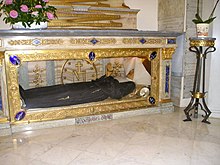Catherine Laboré
Catherine Laboure (* 2. May 1806 in Fain-lès-Moutiers , Burgundy as Zoé Labouré ; † 31 December 1876 in Paris ) was a Roman Catholic nun, which stated in a Marian apparition commissioned to produce the Miraculous Medals get to have. She is venerated as a saint in the Catholic Church .
Life
She was born the eighth of ten children of farmer Pierre Labouré. After her mother's death on October 9, 1815, she moved to the village of Saint-Rémy, 9 kilometers away, and was brought up by her aunt. After two years she returned home and, when her older sister entered the daughters of Christian love of St. Vincent de Paul (French: Filles de la Charité ) in 1818, she ran the household together with her sister Tonine.
She was only able to attend school when she was 18 and learn to read and write there. Her father initially did not allow the daughters of Christian love to enter. She worked with her brother in Paris and then in a boarding school in Châtillon-sur-Seine .
Finally, on April 21, 1830, she received permission to enter the community of the Daughters of Christian Love in Paris. She received the religious name Catherine. On July 19, 1830, she is said to have had the first apparition of Mary , another followed on November 27.

Catherine reported seeing Mary standing on the globe within an oval frame. The apparition was surrounded by the words "O Mary, received without sin , pray for us who take refuge in you". She also saw a large letter M with a cross over it and the stylized hearts of Jesus and Mary. This apparition asked her to mint medals with these pictures and promised "all who wear them will receive great graces".
Catherine told her superior and confessor, Father Aladele, about this vision, but at first neither of them believed her. After a renewed apparition of Mary, Father Aladele received permission from Archbishop de Quelen to mint the medals in 1832. Wonderful healing experiences made the medal very popular and led to the designation "miraculous medal". The proclamation of the dogma of the Immaculate Conception of Mary by Pope Pius IX. on December 8, 1854 promoted the spread of this medal.
Catherine worked the rest of her life as an ordinary nurse in a retirement home in Enghien . Only shortly before her death did her sisters find out that it was she who had given the order to mint the medals after an apparition of Mary.
Aftermath
Catherine Labouré's body lies in a glass shrine on the side altar of the monastery chapel of the mother house of the Cooperative of the Daughters of Christian Love of St. Vincent de Paul (formerly Hôtel de la Vallière) on Rue du Bac in Paris. Labouré was saved on May 28, 1933 and on July 27, 1947 by Pope Pius XII. canonized . Her feast day is the anniversary of her death, December 31st.
literature
- Edmund Crapez: The venerable Katharina Labouré, merciful sister of St. Vincent de Paul. Verlag der Missionsiester, Graz 1913.
- Maria Cuylen: Saint Catherine Labouré and the Miraculous Medal of the Immaculate . 7th edition Kanisius, Freiburg / Switzerland 2000, ISBN 3-85764-031-6 .
- Peter Josef Erbes: Shining hands over Paris. Katharina Labouré and the winning run of the wonderful medal . Credo, Wiesbaden 1952.
- René Laurentin : Petite vie de Catherine Labouré, voyante de la rue du Bac et servante des pauvres. Desclée, Paris 1991, ISBN 2-220-03185-3 .
- Ida Lüthold-Minder : Triumphant advance of the wonderful medal . 9th edition Miriam, Jestetten 1999.
Web links
- Katharina Labore information in the Ecumenical Lexicon of Saints
- Apparition of Mary in Paris 1830
- Official website of the Apparition Chapel on Rue du Bac, Paris
Individual evidence
- ↑ René Laurentin: Petite vie de Catherine Laboré, voyante de la rue du Bac et servante des pauvres. Paris 1991, p. 7: Elle est la huitième des dix enfants qui viennent de perdre leur maman. Other biographies include eleven children, the ninth of which was Catherine, e. B. Crapez (see lit.) p. 10; Cuylen (see lit.) p. 42. The reason for the discrepancy is probably the early death of a little brother.
- ↑ Cuylen (see Lit.), p. 74.
| personal data | |
|---|---|
| SURNAME | Labouré, Catherine |
| ALTERNATIVE NAMES | Labouré, Katharina; Labouré, Zoé |
| BRIEF DESCRIPTION | Roman Catholic nun who received the order to produce miraculous medals in an apparition of Mary |
| DATE OF BIRTH | May 2, 1806 |
| PLACE OF BIRTH | Fain-lès-Moutiers , Burgundy |
| DATE OF DEATH | December 31, 1876 |
| Place of death | Paris |


